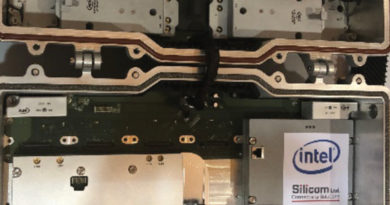Creating Smarter HFC Networks with AI/ML Technologies
By Esteban Sandion and Diana Linton –
Artificial intelligence (AI) and machine learning (ML) tools are enabling new ways to optimize HFC network design, performance and efficiency. Telemetry data can be used to dynamically tune amplifier gain, output level and performance while staying well above amplifier thermal noise floors and avoiding operation within the amplifier non-linear regions. Optimizing amplifier gain to better reflect actual network conditions may reduce the maximum gain requirements for individual amplifiers and lead to better RF designs and deployments.
Machine learning techniques can also be used to identify RF signal impairments and develop automated solutions for intelligent network applications to detect and resolve signal issues. Furthermore, optimal CPE RF operating margins can be leveraged to set appropriate RF gain for outside plant amplifiers, which takes advantage of future smart capabilities expected in the next generation of 1.8 GHz amplifiers. Efforts are underway to fully leverage both smart features of new amplifiers and the wealth of data that can be collected from those devices. Let’s review some of the critical areas that can benefit from adoption of AI and ML technologies.
Network design improvements
Network operators implement a drop-in approach to maintain amplifier legacy locations by installing a new amplifier module with higher downstream and/or upstream bandwidth, helping minimize upgrade downtime and cost. As higher attenuation values are introduced at 1.8 GHz and even higher operating frequencies, amplifier output levels must be raised. This requires high gain amplifiers with a high degree of linearity that can handle large signal swings without distortion, while maintaining efficiency so the amplifier does not exceed power consumption limits. Total composite power (TCP) levels must increase to support higher operating bandwidths, up to a limit. To ensure TCP limits are not exceeded, performance over existing coaxial cable spans must be carefully monitored to preserve signal quality. This also means ensuring consistent amplifier RF gain and output levels to maintain unity gain and facilitate amplifier alignment.
To ensure TCP is managed properly, operators must control amplifier parameters tightly and optimize output levels and gain levels. Intelligent tools can be used to establish and leverage optimal RF operating margins for amplifiers and CPE to increase design effectiveness. CPE telemetry, including downstream and upstream signal strength and RxMER performance and errors, can also be analyzed to glean information about RF signals’ health and performance through the HFC network. Similarly, telemetry from smart amplifiers and nodes can be collected and combined with CPE data to select optimal amplifier gain profiles. Such optimized profiles can target all CPE within a given geography while minimizing excessive RF levels into the home.
Optimizing RF signal performance
In HFC networks, nonlinear distortions limit RF output levels and determine RF signals’ maximum reach. They also determine the maximum number of RF channels supported by active devices. For today’s digital carriers, the resulting nonlinear distortions and intermodulation products are noise-like and generally indistinguishable from random noise. The severity of these intermodulation products is affected by signal levels and nonlinear interactions in RF amplifier components. This is why it is critical to carefully manage TCP in active devices. This kind of device monitoring and performance optimization requires continuous data collection and analysis which can benefit from the introduction of intelligent tools.
Interference and noise detection and mitigation
Challenges in RF level optimization include identifying the sources of external interference and noise, designing a system that is resilient to interference and noise, and maintaining a constant level of signal power across the length of the coaxial cable. Thus, when network operators implement network intelligence tools, interference and noise mitigation must be considered as part of the optimization process.
HFC systems that are AI-driven can dynamically adapt to changing network conditions, which is one of their major advantages. HFC network performance is influenced by factors such as user demand, signal impairments and signal degradation over amplifier cascades. Implementing AI algorithms that can continuously analyze these variables and adjust signal amplification, modulation orders and RF profiles ensures optimal signal quality throughout the network. Adaptability results in consistent and better end-to-end performance, minimizing disruptions and improving the customer experience.
Based on historical data and usage patterns, AI models can predict potential noise and interference-related problems in active RF devices. In addition, AI algorithms can extract relevant network information such as RF carrier frequency, amplitude, phase and time-domain characteristics. By analyzing these datasets, AI algorithms can identify abnormal patterns indicative of noise, interference or distortions. ML algorithms can also be used to learn from datasets containing both clean and noisy examples of RF signals and classify them as noise-free or noisy using supervised and unsupervised learning techniques to identify anomalous patterns or deviations from expected behavior.
Enabling remote network monitoring and predictive maintenance
Due to the large number of components in the HFC network, implementing monitoring tools has sometimes been a challenge for network operators. Identifying issues may be complex and time-consuming and network operators have often relied on manual debugging and troubleshooting.
AI-driven automated management and monitoring systems can help operators quickly identify and address issues without having to physically access the network. Predictability is invaluable in HFC systems. This foresight enables operators to replace or repair components before they lead to network disruptions. As a result, system downtime is minimized and maintenance becomes a planned, rather than reactive, process.
Reducing network power consumption
The HFC outside plant can benefit significantly by operating at peak efficiency, meaning lowering amplifier output power and reducing power draw when network demand is low. The first benefit of this strategy is that it can reduce HFC networks’ operational costs and their environmental impact through improved energy efficiency. A second benefit of reducing amplifier output power is that it can extend the lifespan of network components, enhancing their reliability and reducing the need for maintenance. Using AI algorithms, amplifier bias can be adjusted to optimize amplifier power efficiency in real time to target periods of low network usage, allowing for dynamic changes to the amplifier to operate at peak efficiency, while saving energy and reducing operating costs.
Conclusion
A key component of operators’ efforts to improve performance, reliability and efficiency is optimizing their HFC networks. Monitoring system parameters, such as RF signal quality and CPE received and transmitted levels, provides operators with valuable information for enhancing service reliability and user experience. Operators can benefit from network intelligence applications to analyze and optimize network performance based on actives and CPE data. Network intelligence applications that expedite collection and analysis of large datasets can enhance service reliability and the user experience. Automation can help identify and resolve issues faster, while network intelligence can provide insight into HFC plant health by monitoring CM and amplifier behavior. This can allow for proactive optimization and quicker troubleshooting. Automation and network intelligence can also help reduce operational downtime and cost, while expediting repairs and improving reliability. Finally, integrating advanced analytics and automation tools into the network design process can help ensure optimal service performance.
HFC systems’ inherent inter-complexities make manual optimization and troubleshooting daunting tasks. With AI, analysis of vast and intricate datasets becomes manageable. AI models can identify patterns, anomalies, and correlations that human operators might overlook, allowing for proactive identification of potential issues. In addition to improving overall efficiency and reducing downtime, AI-driven systems can help identify noise and interference, enhance HFC network capacity and potentially extend HFC network reach.

Esteban Sandino,
Charter Communications
esteban.sandino@charter.com
Esteban Sandino joined Charter in 2018, and holds the position of Distinguished Engineer within the Network Technology Group in Englewood, Colorado. In this role he helps guide the development and implementation of advanced HFC.

Diana Linton,
Charter Communications
diana.linton@charter.com
Diana Linton is a Principal Engineer working at the Charter Technology Engineering Center in Englewood, Colorado. At the end of 2020 Diana joined Charter to support plant network equipment qualification efforts and she actively participates in the development of extended spectrum RF solutions.
Image: Shutterstock



